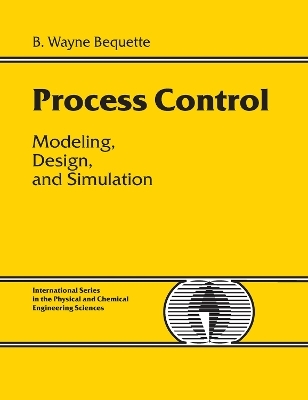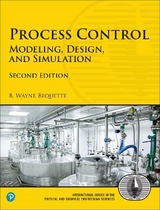
Process Control
Pearson (Verlag)
978-0-13-353640-9 (ISBN)
- Titel erscheint in neuer Auflage
- Artikel merken
For junior or senior-level undergraduate Chemical Engineering courses in process dynamics and control, as well as a reference for professionals seeking the latest simulation tools and advanced control strategies. This is the first book to offer a fully integrated introduction of the fundamental topics of process dynamics with MATLAB software tools that allow students to learn the material interactively through computer-based simulation exercises. Process Control: Modeling, Design and Simulation presents realistic problems and provides the software tools for students to simulate processes and solve practical, real-world problems. Ultimately, the book will teach students to analyze dynamic chemical processes and develop automatic control strategies to operate them safely and economically.
B. WAYNE BEQUETTE is Professor of Chemical Engineering at Rensselaer Polytechnic Institute. His teaching and research interests are in the areas of process systems and control engineering for biomedical systems, pharmaceuticals, chromatography, and complex chemical processes. He is Associate Editor of Automatica, a journal of the International Federation of Automatic Control, and General Chair for the 2003 American Control Conference. He is the author of Process Dynamics: Modeling, Analysis, and Simulation (Prentice Hall).
Preface.
1. Introduction.
Introduction. Instrumentation. Process Models and Dynamic Behavior. Control Textbooks and Journals. A Look Ahead. Summary. Student Exercises.
2. Fundamental Models.
Background. Balance Equations. Material Balances. Constitutive Relationships. Material and Energy Balances. Form of Dynamic Models. Linear Models and Deviation Variables. Summary. Suggested Reading. Student Exercises. Appendix 2.1: Solving Algebraic Equations. Appendix 2.2: Integrating Ordinary Differential Equations.
3. Dynamic Behavior.
Background. Linear State Space Models. Introduction to Laplace Transforms. Transfer Functions. First-Order Behavior. Integrating System. Second-Order Behavior. Lead-Lag Behavior. Poles and Zeros. Processes with Dead Time. Padé Approximation for Dead Time. Converting State Space Models to Transfer Functions. MATLAB and SIMULINK. Summary. References. Student Exercises.
4. Empirical Models.
Introduction. First-Order + Dead Time. Integrator + Dead Time. Discrete-Time Autoregressive Models. Parameter Estimation. Discrete Step and Impulse Response Models. Summary. References. Student Exercises. Appendix 4.1: Files Used to Generate Example 4.4. Appendix 4.2.
5. Introduction to Feedback Control.
Motivation. Development of Control Block Diagrams. Response to Setpoint Changes. PID Controller Algorithms. Routh Stability Criterion. Effect of Tuning Parameters. Response to Disturbances. Open-Loop Unstable Systems. SIMULINK Block Diagrams. Summary. References. Student Exercises.
6. PID Controller Tuning.
Introduction. Closed-Loop Oscillation-Based Tuning. Tuning Rules for First-Order + Dead Time Processes. Direct Synthesis. Summary. References. Student Exercises.
7. Frequency-Response Analysis.
Motivation. Bode and Nyquist Plots. Closed-Loop Stability Concepts. Bode and Nyquist Stability. Robustness. MATLAB Control Toolbox: Bode and Nyquist Functions. Summary. Reference. Student Exercises.
8. Internal Model Control.
Introduction to Model-Based Control. Practical Open-Loop Controller Design. Generalization of the Open-Loop Control Design Procedure. Model Uncertainty and Disturbances. Development of the IMC Structure. IMC Background. The IMC Structure. The IMC Design Procedure. Effect of Model Uncertainty and Disturbances. Improved Disturbance Rejection Design. Manipulated Variable Saturation. Summary. References. Student Exercises. Appendix 8.1: Derivation of Closed-Loop Relationships for IMC.
9. The IMC-Based PID Procedure.
Background. The Equivalent Feedback Form to IMC. IMC-Based Feedback Design for Delay-Free Processes. IMC-Based Feedback Design for Processes with a Time Delay. Summary of IMC-Based PID Controller Design for Stable Processes. IMC-Based PID Controller Design for Unstable Processes. Summary. References. Student Exercises.
10. Cascade and Feed-Forward Control.
Background. Introduction to Cascade Control. Cascade-Control Analysis. Cascade-Control Design. Cascade IMC. Feed-Forward Control. Feed-Forward Controller Design. Summary of Feed-Forward Control. Combined Feed-Forward and Cascade. Summary. References. Student Exercises-Cascade Control. Student Exercises-Feed-Forward Control. Student Exercises-Feed-Forward and Cascade.
11. PID Enhancements.
Background. Antireset Windup. Autotuning Techniques. Nonlinear PID Control. Controller Parameter (Gain) Scheduling. Measurement/Actuator Selection. Implementing PID Enhancements in SIMULINK. Summary. References. Student Exercises.
12. Ratio, Selective, and Split-Range Control.
Motivation. Ratio Control. Selective and Override Control. Split-Range Control. SIMULINK Functions. Summary. References. Student Exercises.
13. Control-Loop Interaction.
Introduction. Motivation. The General Pairing Problem. The Relative Gain Array. Properties and Application of the RGA. Return to the Motivating Example. RGA and Sensitivity. Using the RGA to Determine Variable Pairings. MATLAB RGA Function File. Summary. References. Student Exercises. Appendix 13.1: Derivation of the Relative Gain for an n-Input-n-Output System. Appendix 13.2: m-File to Calculate the RGA.
14. Multivariable Control.
Background. Zeros and Performance Limitations. Scaling Considerations. Directional Sensitivity and Operability. Block-Diagram Analysis. Decoupling. IMC. MATLAB tzero, svd, and LTI Functions. Summary. References. Student Exercises. Appendix 14.1.
15. Plantwide Control.
Background. Steady-State and Dynamic Effects of Recycle. Unit Operations Not Previously Covered. The Control and Optimization Hierarchy. Further Plantwide Control Examples. Simulations. Summary. References. Student Exercises.
16. Model Predictive Control.
Motivation. Optimization Problem. Dynamic Matrix Control. Constraints and Multivariable Systems. Other MPC Methods. MATLAB. Summary. References and Relevant Literature. Student Exercises. Appendix 16.1: Derivation of the Step Response Formulation. Appendix 16.2: Derivation of the Least Squares Solution for Control Moves. Appendix 16.3.
17. Summary.
Overview of Topics Covered in This Textbook. Process Engineering in Practice. Suggested Further Reading. Notation. Student Exercises.
Module 1. Introduction to MATLAB.
Background. Matrix Operations. The MATLAB Workspace. Complex Variables. Plotting. More Matrix Stuff. For Loops. m-Files. Summary of Commonly Used Commands. Frequently Used MATLAB Functions. Additional Exercises.
Module 2. Introduction to SIMULINK.
Background. Open-Loop Simulations. Feedback-Control Simulations. Other Commonly Used Icons. Developing Alternative Controller Icons. Summary. Additional Exercises.
Module 3. Ordinary Differential Equations.
MATLAB ode-Basic. MATLAB ode-Options. SIMULINK sfun (.mdl Files). SIMULINK sfun (.mdl Files)-Advanced. Summary.
Module 4. MATLAB LTI Models.
Forming Continuous-Time Models. Forming Discrete-Time Models. Converting Continuous Models to Discrete. Converting Discrete Models to Continuous. Step and Impulse Responses. Summary. Reference. Additional Exercises.
Module 5. Isothermal Chemical Reactor.
Background. Model (Chapter 2). Steady-State and Dynamic Behavior (Chapter 3). Classical Feedback Control (Chapters 5 and 6). Internal Model Control (Chapter 8). Reference. Additional Exercises.
Module 6. First-Order + Time-Delay Processes.
Motivation. Closed-Loop Time-Domain Simulation. Bode Analysis. Ziegler-Nichols Tuning. IMC-Based PID Control. Summary. References. Additional Exercises. Appendix M6.1.
Module 7. Biochemical Reactors.
Background. Steady-State and Dynamic Behavior. Stable Steady-State Operating Point. Unstable Steady-State Operating Point. SIMULINK Model File. Reference. Additional Exercises.
Module 8. CSTR.
Background. Simplified Modeling Equations. Example Chemical Process-Propylene Glycol Production. Effect of Reactor Scale. For Further Study: Detailed Model. Other Considerations. Summary. References. Additional Exercises. Appendix M8.1.
Module 9. Steam Drum Level.
Background. Process Model. Feedback Controller Design. Feed-Forward Controller Design. Three-Mode Level Control. Appendix M9.1: SIMULINK Diagram for Feed-Forward/Feedback Control of Steam Drum Level. Appendix M9.2: SIMULINK Diagram for 3-Mode Control of Steam Drum Level.
Module 10. Surge Vessel Level Control.
Background. Process Model. Controller Design. Numerical Example. Summary. Reference. Additional Exercises. Appendix M10.1: The SIMULINK Block Diagram.
Module 11. Batch Reactor.
Background. Batch Model 1: Jacket Temperature Manipulated. Effect of Scale (Size). Quasi-Steady-State Behavior IMC-Based Design. Batch Model 2: Jacket Inlet Temperature Manipulated. IMC-Based PID Tuning Parameters. Batch Model 3: Cascade Control. Summary. Reference. Additional Exercises.
Module 12. Biomedical Systems.
Overview. Pharmacokinetic Models. Intravenous Delivery of Anesthetic Drugs. Blood Glucose Control in Diabetic Patients. Blood Pressure Control in Post-Operative Patients. Critical Care Patients. Summary. References. Additional Exercises.
Module 13. Distillation Control.
Description of Distillation Control. Open-Loop Behavior. SISO Control. RGA Analysis. Multiple SISO Controllers. Singular Value Analysis. Nonlinear Effects. Other Issues in Distillation Column Control. Summary. References. Additional Exercises. Appendix M13.1.
Module 14. Case Study Problems.
Background. Reactive Ion Etcher. Rotary Lime Kiln Temperature Control. Fluidized Catalytic Cracking Unit. Anaerobic Sludge Digester. Drug Infusion System. Suggested Case Study Schedule. Summary. Additional Exercises.
Module 15. Flow Control.
Motivating Example. Flowmeters. Control Valves. Pumping and Piping Systems. Summary. References. Additional Exercises.
Module 16. Digital Control.
Background. PID Controllers. Stability Analysis for Digital Control Systems. Performance of Digital Control Systems. Discrete IMC. Summary.
References.
Additional Exercises.
Appendix M16.1: SIMULINK .mdl File for Example M16.2.
Appendix M16.2: SIMULINK .m and .mdl Files for Example M16.3.
Index.
About the Author.
| Erscheint lt. Verlag | 22.1.2003 |
|---|---|
| Reihe/Serie | International Series in the Physical and Chemical Engineering Sciences |
| Mitarbeit |
Herausgeber (Serie): Trow/Argosy |
| Sprache | englisch |
| Maße | 182 x 238 mm |
| Gewicht | 1340 g |
| Themenwelt | Mathematik / Informatik ► Mathematik ► Angewandte Mathematik |
| Naturwissenschaften ► Chemie ► Technische Chemie | |
| Technik | |
| ISBN-10 | 0-13-353640-8 / 0133536408 |
| ISBN-13 | 978-0-13-353640-9 / 9780133536409 |
| Zustand | Neuware |
| Informationen gemäß Produktsicherheitsverordnung (GPSR) | |
| Haben Sie eine Frage zum Produkt? |
aus dem Bereich



